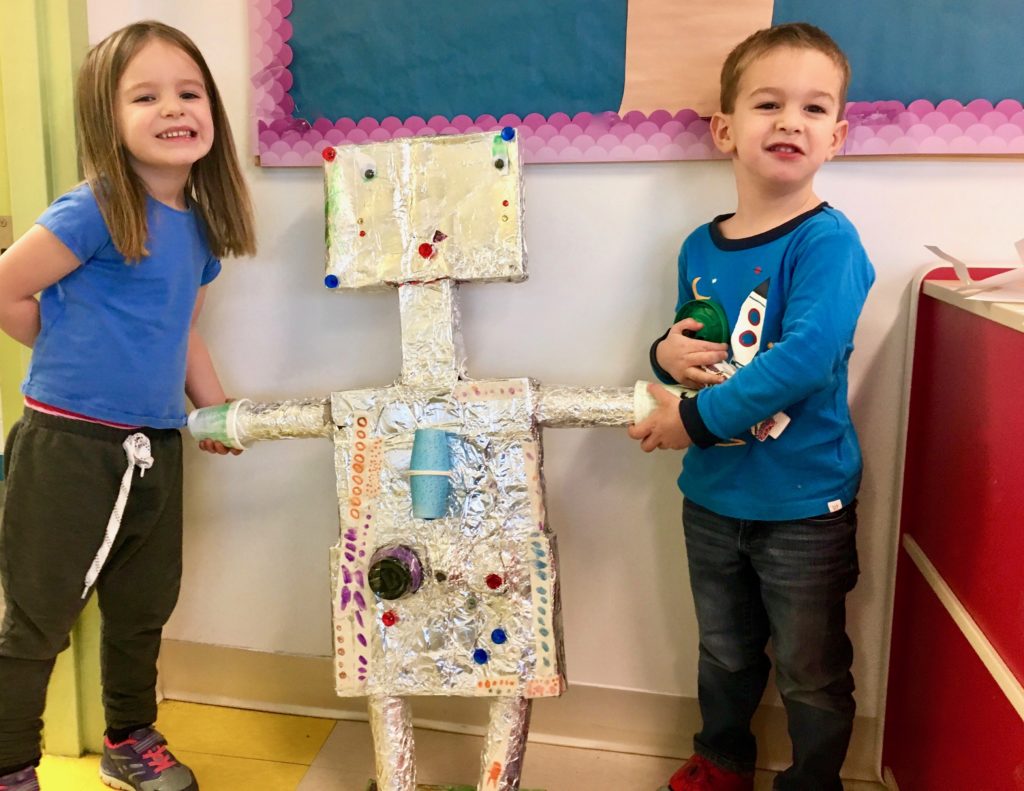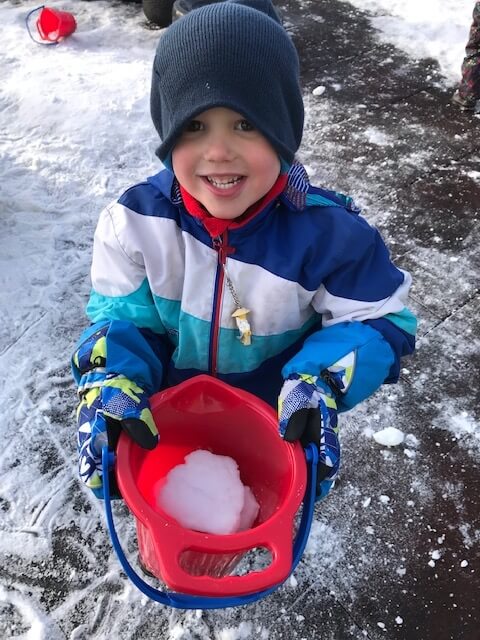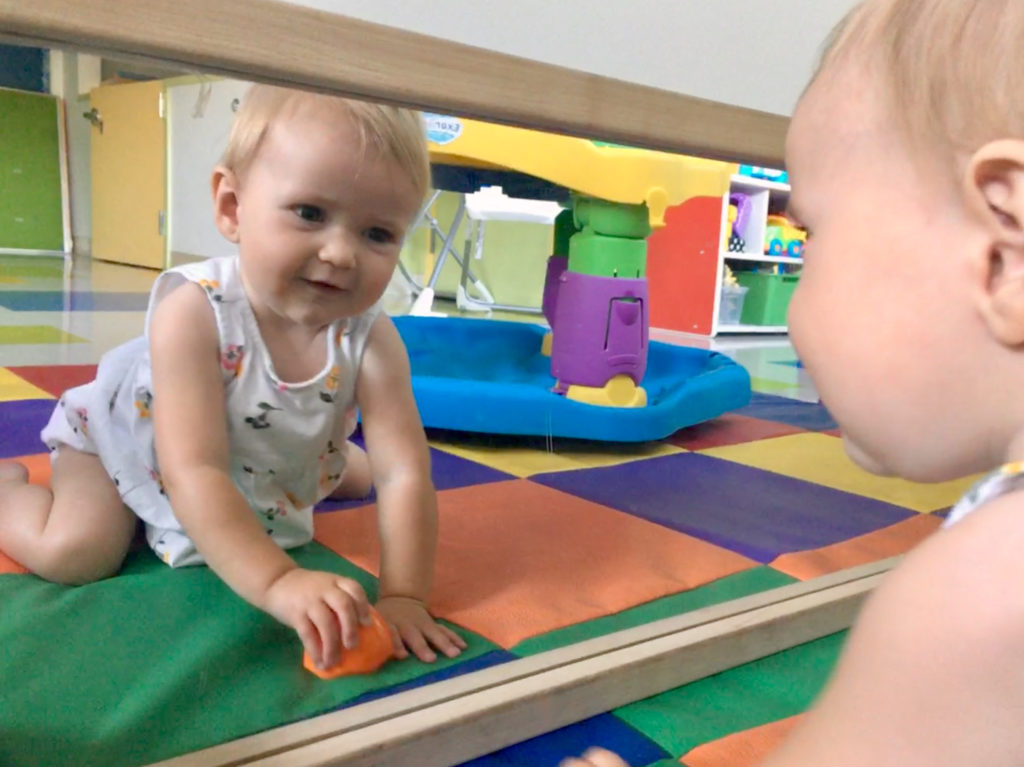Summer Camp 2025 Registration is Open – click here to register now!
Kids & Company Blog
What is ’emergent curriculum’ all about?
As the parent of three children, and someone who works alongside some of the brightest Early Childhood Educators in the country, I've come to understand and deeply appreciate the Emergent Curriculum philosophy practiced at Kids & Company. Sometimes referred to as cue-based or child-centred learning, the approach is relatively simple in theory, but can be complicated in application. It takes an engaged, well-trained and astute teacher to observe the fine cues and “emerging” interests of the children. And, to use those cues to facilitate an environment that is stimulating, exploratory and at the appropriate level. In our centres, we implement the curriculum with specific developmental objectives and learning outcomes. Our teachers also have the flexibility to plan their programming in accordance to what will engage the children curiosity, and empower them to actively participate in their education.
What is emergent curriculum?
The term emergent curriculum loosely captures the idea that the types of learning a child is ready to do will emerge when a teacher facilities an environment where they feel secure, engaged and interested. Instead of a rigid lesson plan, the teacher has broader goals of encouraging curiosity, play, exploration, collaboration and creativity by exploring content that the children demonstrate interest in.
Emergent Curriculum is a philosophy of teaching and way of planning curriculum that focuses on being responsive to children's interests to create meaningful learning experiences. It can be practiced at any grade level. This philosophy prioritizes active participation, relationship building, flexible and adaptable methods, inquiry, and play-based learning. Curriculum is child-initiated, collaborative and responsive to the children's needs. Proponents of this style of teaching advocate that knowledge of the children is the key to success in the program. To plan an emergent curriculum requires observation, documentation, creative brainstorming, flexibility and patience. Rather than starting with a lesson plan which requires a “hook” to get the children interested, emergent curriculum starts with the observation of the children for insight into their interests. The classroom typically consists of learning centres that expand and facilitate children's learning and encourage independent learning skills.
Source: wikipedia.org
What tools are needed to successfully engage in emergent curriculum?
- Observation- a strong teacher must find ways to tune in to the interests and skills of the children to identify where to take conversations, explorations and new activities. Listening to students encourages them to find their voice and help direct learning that engages children.
- The Learning Environment- not only are teachers crucial in creating a safe and open experience for children, the environments are intentionally set up with learning centres that focus on different discoveries and skills, and are set up in ways that are particularly accessible to children. These centres also allow for flexibility to work in different group sizes or do individual learning to address different needs at different times.
- Documentation- In alignment with provincial standards for early education, Kids & Company prioritizes active documentation through internal observation notes, parent communications, and visual representations of the children's learning and interests within the actual centre.
What are examples of emergent curriculum in application?
Our children thrive in the emergent curriculum environment and we love regularly hearing from teachers about their focuses, new developments, discoveries and teamwork efforts. Here are some of my favourite examples of emergent curriculum in action:
- In my five-year-old's class, discussions arose about the difference between living things and non-living things - and with that, a series of learning opportunities emerged for the teachers to help the children explore. They shared their experiences and observations and came to various conclusions. To test one of the theories, the children decided to build their own robot to help determine if it was indeed a living thing. They brainstormed the types of materials needed and how they would construct it. They were so excited, they spent several days working on their project. There was a lot of pride in the finished piece and it prompted the realization that they could build other 'life-like' creations using unexpected materials. This resulted in the creation of a child-sized wooden-block Santa Claus. Although, the robot and Santa were amazing to see as a parent, both the teacher and I knew the journey to get there had been even more valuable. There were many discussions involving biology, lessons in collaboration and teamwork, planning and execution; which spanned all of the developmental domains.

- One day the Director at our centre observed an interesting connection that our three-year-old made between some books they were reading on dinosaurs and an activity he chose to do outside. She emailed us to say, “I wanted to share a WOW moment with you. This morning, during outside play, Oscar was excited to dig through the snow. He pretended to find fossils buried deep underneath the ground. This connection is significant because we are currently talking about fossils, how they are formed, and where they are found, in our classroom. So, it is neat to see he is taking that a step further. It demonstrates cognitive reasoning, connecting ideas and continued development of his fine motor skills. Way to go Oscar!"

- Our 14-month-old daughter has been slow to begin walking. She prefers to scoot around on her bottom. In her classroom, she is the only one not toddling about yet. Her teachers have been encouraging her to practice standing, reaching, walking with assistance and pulling herself up. One of her teachers suggested that Mae probably didn't feel that motivated to walk with two older brothers who constantly brought toys. I was so touched when she recounted the achievements Mae had been making and showed me how the room had been set up with unique areas to discover for an active crawler. They had ensured her environment was well-stocked for Mae to explore, play, learn and thrive. Even with infants and toddlers, a teacher trained in emergent curriculum is always observing, facilitating and thinking about the experience and development of the child, both cognitively and physically.

By: Melissa Sawatzky
Melissa lives in Calgary and is the Director of Brand Strategy for Kids & Company. Her vision of what she would be like as a mom was shattered years ago when she discovered nothing ever goes as planned for parents, but laughter and community sees you through. You can reach her at msawatzky@kidsandcompany.com.
Posted on: Wednesday December 19th, 2018
Posted by: Melissa Sawatzky
Calgary
Calgary
Calgary
Calgary
Calgary
Edmonton
Cochrane
Red Deer
Calgary
Calgary
Okotoks
Calgary
Calgary
Calgary
Calgary
Edmonton
St. Albert
Edmonton
Edmonton
Edmonton
Edmonton
Edmonton
Edmonton
Edmonton
St. Albert
Edmonton
Edmonton
Sylvan Lake
Edmonton
Sherwood Park
Edmonton
Calgary
Edmonton
Calgary
Kamloops
Langley
Langley
New Westminster
North Vancouver
Richmond
Vancouver
Victoria
Victoria
Port Moody
Surrey
Surrey
Surrey
North Vancouver
Nanaimo
Surrey
Coquitlam
Burnaby
Port Coquitlam
Vancouver
Maple Ridge
Maple Ridge
Maple Ridge
Mission
Maple Ridge
Maple Ridge
Maple Ridge
Maple Ridge
Mission
Mission
Maple Ridge
Maple Ridge
Chicago
Chicago
Chicago
Chicago
Schaumburg
Chicago
Winnipeg
Abington
Canton
Quincy
West Quincy
Braintree
Braintree
Walpole
East Walpole
Brighton
Brookline
Jamaica Plain
Jamaica Plain
Cambridge
Needham
Newton Highlands
Newton
Cambridge
Boston
Randolph
Kingston
St. Peters
Lake St. Louis
Troy
O'Fallon
St. Charles
Lake St. Louis
St. Peters
O'Fallon
Howell Township
Freehold Township
Manalapan Township
Stratford
Marlton
West Deptford
Bedford
Dartmouth
Halifax
Bedford
Hammonds Plains
Lower Sackville
Eastern Passage
Avon Lake
Beachwood
Hudson
Medina
Strongsville
Cleveland
Westlake
Aurora
Burlington
Burlington
Etobicoke
Etobicoke
Hamilton
London
Milton
Mississauga
Ottawa
Richmond Hill - Corporate office (No child care services)
Toronto
Toronto
Toronto
Toronto
Toronto
Waterloo
Kanata
Oakville
Oakville
Toronto
Whitby
Toronto
Mississauga
Ottawa
Toronto
Toronto
Toronto
Brampton
Stoney Creek
Toronto
Nepean
Burlington
Burlington
Oakville
Waterdown
Oakville
Pittston
Wilkes-Barre
Exeter
Old Forge
Dover
Harrisburg
Harrisburg
Harrisburg
Hummelstown
Palmyra
York
York
York
Sweet Kiddles Avon Lake, part of the Kids & Company Family
Abington
Aurora
Sweet Kiddles Beachwood, part of the Kids & Company Family
Bedford (Dellridge Lane)
Larry Uteck (Southgate Dr)
Pine Village South End, by Kids & Company
Braintree 1
Braintree 2
Brampton
Pine Village Brighton, by Kids & Company
Pine Village Brookline, by Kids & Company
Burlington Children’s Centre
Burloak
Appleby
Beacon Hill
Brightstart Burnaby, by Kids & Company
Bow Trail
Livingston
Midlake
Millrise
Royal Oak
Britannia Crossing
Marda Loop
Evanston
Beltline
Aviation Crossing
Gulf Canada Square
Royal Oak Out of School Care and Child Care
Glendeer: New – Open for Enrollment
Pine Village Kendall Square, by Kids & Company
Pine Village Porter Square, by Kids & Company
Canton
Jackson
Lincoln Park
Harrison
West Loop
Fulton
Sweet Kiddles University Circle, part of the Kids & Company Family
Cochrane
Brightstart Coquitlam, by Kids & Company
Dartmouth
Dover
Walpole North
Eastern Passage
Ellerslie
Edmonton Ice District
Baturyn
Diamond
Friendly Frog
Meadowlark Park
St. Charles
St. Dominic
Sunshine Factory
Tamarack
Jagare Ridge
Horse Hill
Fraser
Century Park: New – Open for Enrollment
Islington
Etobicoke (Bloor & Islington)
ABC Kiddie Kampus Exeter, by Kids & Company
Apple Hill Academy Freehold by Kids & Company
Halifax
Hamilton
Hammonds Plains
Route 39
Schaffner
Swatara
Apple Hill Academy Howell by Kids & Company
Sweet Kiddles Hudson, part of the Kids & Company Family
Hummelstown
Pine Village JP Revere, by Kids & Company
Pine Village JP South Street, by Kids & Company
Kamloops
Eagleson (South Kanata)
Crayon College, by Kids & Company
Tyke Town Lake St. Louis, by Kids & Company
ABC Lake St. Louis, by Kids & Company
Kids World
Langley (200th St.)
London Richmond
Sackville
Apple Hill Academy Manalapan by Kids & Company
119 Avenue, Part of the Kids & Company Family
Dewdney House (Infant/Toddler and 3-5), Part of the Kids & Company Family
Dewdney Church (Preschool/OSC/3-5), Part of the Kids & Company Family
Edge, Part of the Kids & Company Family
Webster’s Corner, Part of the Kids & Company Family
Harry Hooge, Part of the Kids & Company Family
Alouette, Part of the Kids & Company Family
Silver Valley, Part of the Kids & Company Family
Whonnock, Part of the Kids & Company Family
Under The Sun Marlton, part of the Kids & Company Family
Sweet Kiddles Medina, part of the Kids & Company Family
Milton
Lougheed, Part of the Kids & Company Family
Stave Falls, Part of the Kids & Company Family
Briskham, Part of the Kids & Company Family
Robert Speck Parkway
Mississauga Gateway Centre
Nanaimo
Pine Village Needham, by Kids & Company
Ottawa Barrhaven
New Westminster
Pine Village West Newton, by Kids & Company
Pine Village Newton Highlands, by Kids & Company
North Vancouver
North Van Esplanade
O’Fallon South
ABC O’Fallon, by Kids & Company
Oakville Cornwall
Oakville Dundas
Joshua Creek
Oakville West (3471 Wyecroft Rd)
Okotoks
ABC Kiddie Kampus Old Forge, by Kids & Company
Ottawa Albert
Ottawa Westboro
Palmyra
ABC Kiddie Kampus Pittston, by Kids & Company
Brightstart Port Coquitlam, by Kids & Company
Port Moody
Marina Bay
Randolph
Red Deer
Richmond
Head Office
Schaumburg
Sherwood Park
St. Albert North
St. Albert Grandin
ABC St. Charles, by Kids & Company
Tyke Town St. Peters, by Kids & Company
ABC St. Peters, by Kids & Company
Stoney Creek
Under The Sun Stratford, part of the Kids & Company Family
Sweet Kiddles Strongsville, part of the Kids & Company Family
Morgan Crossing
Surrey Professional Centre
King George
Brightstart Cloverdale, by Kids & Company
Sylvan Lake
Bloor Christie
Bloor (Bloor St. East)
Consumers
Finch
Front
Scotia Plaza
Stockyards
St. Andrew’s Church
Liberty Village
Rosedale
Queen West
Tyke Town Troy, by Kids & Company
Vancouver West
Cambie
Langford
Victoria
Walpole South
Waterdown
Tech Town
Under The Sun West Deptford, part of the Kids & Company Family
West Quincy
Sweet Kiddles Westlake, part of the Kids & Company Family
Whitby
ABC Kiddie Kampus East Mountain, by Kids & Company
Winnipeg
West York
Queen Street
Keystone Early Learning Academy, part of the Kids & Company Family
Calgary
Calgary
Calgary
Calgary
Calgary
Edmonton
Cochrane
Red Deer
Calgary
Calgary
Okotoks
Calgary
Calgary
Calgary
Calgary
Edmonton
St. Albert
Edmonton
Edmonton
Edmonton
Edmonton
Edmonton
Edmonton
Edmonton
St. Albert
Edmonton
Edmonton
Sylvan Lake
Edmonton
Sherwood Park
Edmonton
Calgary
Edmonton
Calgary
Kamloops
Langley
Langley
New Westminster
North Vancouver
Richmond
Vancouver
Victoria
Victoria
Port Moody
Surrey
Surrey
Surrey
North Vancouver
Nanaimo
Surrey
Coquitlam
Burnaby
Port Coquitlam
Vancouver
Maple Ridge
Maple Ridge
Maple Ridge
Mission
Maple Ridge
Maple Ridge
Maple Ridge
Maple Ridge
Mission
Mission
Maple Ridge
Maple Ridge
Chicago
Chicago
Chicago
Chicago
Schaumburg
Chicago
Winnipeg
Abington
Canton
Quincy
West Quincy
Braintree
Braintree
Walpole
East Walpole
Brighton
Brookline
Jamaica Plain
Jamaica Plain
Cambridge
Needham
Newton Highlands
Newton
Cambridge
Boston
Randolph
Kingston
St. Peters
Lake St. Louis
Troy
O'Fallon
St. Charles
Lake St. Louis
St. Peters
O'Fallon
Howell Township
Freehold Township
Manalapan Township
Stratford
Marlton
West Deptford
Bedford
Dartmouth
Halifax
Bedford
Hammonds Plains
Lower Sackville
Eastern Passage
Avon Lake
Beachwood
Hudson
Medina
Strongsville
Cleveland
Westlake
Aurora
Burlington
Burlington
Etobicoke
Etobicoke
Hamilton
London
Milton
Mississauga
Ottawa
Richmond Hill - Corporate office (No child care services)
Toronto
Toronto
Toronto
Toronto
Toronto
Waterloo
Kanata
Oakville
Oakville
Toronto
Whitby
Toronto
Mississauga
Ottawa
Toronto
Toronto
Toronto
Brampton
Stoney Creek
Toronto
Nepean
Burlington
Burlington
Oakville
Waterdown
Oakville
Pittston
Wilkes-Barre
Exeter
Old Forge
Dover
Harrisburg
Harrisburg
Harrisburg
Hummelstown
Palmyra
York
York
York
Sweet Kiddles Avon Lake, part of the Kids & Company Family
Abington
Aurora
Sweet Kiddles Beachwood, part of the Kids & Company Family
Bedford (Dellridge Lane)
Larry Uteck (Southgate Dr)
Pine Village South End, by Kids & Company
Braintree 1
Braintree 2
Brampton
Pine Village Brighton, by Kids & Company
Pine Village Brookline, by Kids & Company
Burlington Children’s Centre
Burloak
Appleby
Beacon Hill
Brightstart Burnaby, by Kids & Company
Bow Trail
Livingston
Midlake
Millrise
Royal Oak
Britannia Crossing
Marda Loop
Evanston
Beltline
Aviation Crossing
Gulf Canada Square
Royal Oak Out of School Care and Child Care
Glendeer: New – Open for Enrollment
Pine Village Kendall Square, by Kids & Company
Pine Village Porter Square, by Kids & Company
Canton
Jackson
Lincoln Park
Harrison
West Loop
Fulton
Sweet Kiddles University Circle, part of the Kids & Company Family
Cochrane
Brightstart Coquitlam, by Kids & Company
Dartmouth
Dover
Walpole North
Eastern Passage
Ellerslie
Edmonton Ice District
Baturyn
Diamond
Friendly Frog
Meadowlark Park
St. Charles
St. Dominic
Sunshine Factory
Tamarack
Jagare Ridge
Horse Hill
Fraser
Century Park: New – Open for Enrollment
Islington
Etobicoke (Bloor & Islington)
ABC Kiddie Kampus Exeter, by Kids & Company
Apple Hill Academy Freehold by Kids & Company
Halifax
Hamilton
Hammonds Plains
Route 39
Schaffner
Swatara
Apple Hill Academy Howell by Kids & Company
Sweet Kiddles Hudson, part of the Kids & Company Family
Hummelstown
Pine Village JP Revere, by Kids & Company
Pine Village JP South Street, by Kids & Company
Kamloops
Eagleson (South Kanata)
Crayon College, by Kids & Company
Tyke Town Lake St. Louis, by Kids & Company
ABC Lake St. Louis, by Kids & Company
Kids World
Langley (200th St.)
London Richmond
Sackville
Apple Hill Academy Manalapan by Kids & Company
119 Avenue, Part of the Kids & Company Family
Dewdney House (Infant/Toddler and 3-5), Part of the Kids & Company Family
Dewdney Church (Preschool/OSC/3-5), Part of the Kids & Company Family
Edge, Part of the Kids & Company Family
Webster’s Corner, Part of the Kids & Company Family
Harry Hooge, Part of the Kids & Company Family
Alouette, Part of the Kids & Company Family
Silver Valley, Part of the Kids & Company Family
Whonnock, Part of the Kids & Company Family
Under The Sun Marlton, part of the Kids & Company Family
Sweet Kiddles Medina, part of the Kids & Company Family
Milton
Lougheed, Part of the Kids & Company Family
Stave Falls, Part of the Kids & Company Family
Briskham, Part of the Kids & Company Family
Robert Speck Parkway
Mississauga Gateway Centre
Nanaimo
Pine Village Needham, by Kids & Company
Ottawa Barrhaven
New Westminster
Pine Village West Newton, by Kids & Company
Pine Village Newton Highlands, by Kids & Company
North Vancouver
North Van Esplanade
O’Fallon South
ABC O’Fallon, by Kids & Company
Oakville Cornwall
Oakville Dundas
Joshua Creek
Oakville West (3471 Wyecroft Rd)
Okotoks
ABC Kiddie Kampus Old Forge, by Kids & Company
Ottawa Albert
Ottawa Westboro
Palmyra
ABC Kiddie Kampus Pittston, by Kids & Company
Brightstart Port Coquitlam, by Kids & Company
Port Moody
Marina Bay
Randolph
Red Deer
Richmond
Head Office
Schaumburg
Sherwood Park
St. Albert North
St. Albert Grandin
ABC St. Charles, by Kids & Company
Tyke Town St. Peters, by Kids & Company
ABC St. Peters, by Kids & Company
Stoney Creek
Under The Sun Stratford, part of the Kids & Company Family
Sweet Kiddles Strongsville, part of the Kids & Company Family
Morgan Crossing
Surrey Professional Centre
King George
Brightstart Cloverdale, by Kids & Company
Sylvan Lake
Bloor Christie
Bloor (Bloor St. East)
Consumers
Finch
Front
Scotia Plaza
Stockyards
St. Andrew’s Church
Liberty Village
Rosedale
Queen West
Tyke Town Troy, by Kids & Company
Vancouver West
Cambie
Langford
Victoria
Walpole South
Waterdown
Tech Town
Under The Sun West Deptford, part of the Kids & Company Family
West Quincy
Sweet Kiddles Westlake, part of the Kids & Company Family
Whitby
ABC Kiddie Kampus East Mountain, by Kids & Company
Winnipeg
West York
Queen Street
Keystone Early Learning Academy, part of the Kids & Company Family




